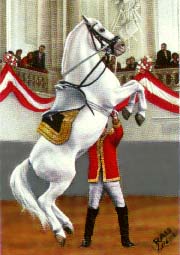Lipizzan / Lippizzaner
N/A
Tue, 24th September, 2024 - 8:25 pm GMT
Sponsor Ads:

Alternative Name
N/ABasic Info
Lipizzans are not very tall, the largest stands about 16 hands, but their proud carriage, muscular bodies and elastic, powerful movements make them appear much larger than they really are. Lipizzans are late maturing and long lived, many times to 35 or more years of age. Lipizzans display elegance and nobility as soon as they are born. They are born black or bay and slowly turn "white" by the time they are five to eight years of age. Lipizzans are actually grey; their dark skin hidden under a white coat is not revealed unless they are wet or bear a large scar. They are not fully grown in size until they are seven and do not reach full maturity until almost ten years of age. At one year of age, most Lipizzans look shockingly small compared to a Thoroughbred of the same age. In addition, by the time they are eight months of age most Lipizzans begin to go through the most awkward, ugly duckling stage from which they do not usually emerge until they are about three years old. During this period of awkwardness a typical Lipizzan is barely recognized as a member of his breed. He looks more like a molting mule. In Austria the young Lipizzans are turned out in the alps where no tourists can view them until they are brought back at the age of three. That is when the elegance a Lipizzan possessed at birth returns and is increasingly manifested, even through old age, until the day he dies. The Lipizzan has a head-heavy, lethargic stance when found in the paddock. When he is turned out or ridden, there is an unforgettable display of fiery animation, with head held high, neck arched, nostrils flared and an inborn ability to leave the ground with incredible power and grace. Then, when approached by a person with a kind word, there is yet another transformation, almost instantaneously, to a docile, gentle horse. He displays obedience and a desire to understand and please, yet without losing his proud bearing and superior presence. Lipizzans are of sound, heavy bone and lameness is rare. They are extremely adaptable to frequent or rapid changes in their environment and their feed. It is their easy going nature and adaptability that makes them very easy keepers. These are, no doubt, the same qualities which enabled the breed to survive some thirty years of being protectively marched around Europe to various hiding places. Lipizzans are a joy to ride with their soft, broad backs and lively gait . Their powerful hindquarters allow them to carry themselves with a natural balance. They have a natural sense of rhythm and maintain a very even tempo in all paces without constant adjustment on the part of the rider. They are extremely quiet and steady under saddle. The stallions are extremely docile and easily handled. They are, in fact, easier to manage than the mares. Respect, once earned by the handler, will always be there with the Lipizzan stallions. The mares, on the other hand, tend to be a little bossy in a motherly way and must be reminded from time to time that they cannot pull parental rank on the handler. They rarely shy at anything, and if they do, strangely, it is not for the reasons most horses shy. When a Lipizzan is startled there is no feeling of fear or trembling. His back does not hollow out and leave the rider without a place to sit; rather, a Lipizzan collects himself--his hind legs step under his body, his back elevates, seating his rider even more securely in the saddle. The neck arches, insisting that the rider take up more rein. The horse begins piaffe (a powerful trot in place full of cadence and rhythm) with exhilarating power and boldness. He feels like a coiled spring just waiting for the command to capriole through the air. If instead the rider gives to the horse the smallest amount of rein, the piaffe extends to the passage (a slow motion floating trot). This they do naturally. The Lipizzan makes even a beginning rider believe, just for a moment, that he's an old, respected riding master. He will respond with willingness and heart when respectfully asked to do so, even by the most inexperienced horseperson ... but woe to the person who believes "a horse is a horse" and attempts to display an egotistical desire to bully or intimidate the Lipizzan. When they are truly afraid or their sense of justice is violated by brutality, they stand their ground, look the opponent in the eye, and "royally" prepare for battle--the very purpose for which they were first bred 400 years ago. The number of half-Lipizzans now registered has grown to over 150. The half-Lipizzan owners are considering possibilities for forming their own registry. Crossbreeding has become popular, not only in Europe, but in the United States and Mexico. In Mexico and some parts of the US, Lipizzans are crossbred to quarter horses to produce excellent working cow horses. When bred to Thoroughbreds, they produce exceptional event horses. Arabs are frequently bred to Lipizzans to produce slightly heavier boned Arab-looking horse. Lipizzans consistently impart their proponent qualities of intelligence, temperament, and soundness, (and, in almost all cases, color). It remains to be seen if they impart their longevity to other breeds. Lipizzans will not only continue to gain popularity as more people come to know them, but also as a foundation breed to produce a superior all-around American warmblood sporthorse--and possibly an American warmblood pony breed.
Health
N/AHabitat
N/ABehavior
Lipizzan horses excel in dressage, especially at the upper levels. Most all Lipizzans are outstanding in competition and in upper level movements such as piaffe, passage, and canter pirouettes, with a brilliance not usually seen in other breeds. These abilities are inborn to the Lipizzan. They excel not only as driving and dressage horses, but for jumping, cutting, reining, endurance, trail, vaulting, and of course for pleasure. They are used extensively on the East Coast for handicapped riding programs. In spite of their royalty, they are truly an all-around horse capable of performing whatever task is required. They not only possess beauty and nobility, but also a rare combination of courage, strength, ability, temperament, and intelligence.Origin
AustriaHistory
The Lipizzan breed had its beginning in 1580 when Archduke Charles II established the studfarm in Lipizza (Lipica), using the best imported Spanish horses, Andalusians, Barbs and Berbers bred to the local Karst horses. The Karst horses were white in color, small, slow to mature, and extremely tough. Most people have the false idea that Lipizzans inherited their high stepping gait from the Spanish horse. It was, however, the Karst horse who gave the Lipizzan its high stepping gate. In the late 1700's the horses were moved three times during the Napoleonic Wars. Napolean gained possession of the horses for a while and bred his Arab stallion, VESIR, to the Lipizzaners. Seven Arab stallions were used to develop the breed during the period from 1807 to 1856. They were: SIGLAVY, TADMOR, GAZLAN, SAYDAN, SAMSON, HADUDI, and BEN AZET. From 1792 to 1815, the Kladruby horse helped to develop two of the Lipizzan lines (Maestoso & Favory). By 1880 there were 341 Lipizzan horses at the Lipizza studfarm. Of all the sires used in the 18th and 19th centuries, only six founded the original stallion lines of the Lipizzan breed: SIGLAVY, NEAPOLOTANO, MAESTOSO, FAVORY, PLUTO, and CONVERSANO. Later, in Croatia and Hungary, the TULIPAN and INCITATO lines were developed. Until 1916, the Lipizzan studfarm always remained a private possession of the Habsburg monarchy. Up to this time, the expansion of the breed had been affected over the centuries by military conflicts. Whenever warfare threatened the Lipizza stud, the horses were moved away. During these moves, individual horses would occasionally be given or sold to other studs. From these horses came other small Lipizzan studs, usually within the boundaries of the Austrian empire. During World War I, the breeding stock was relocated to Laxenburg near Vienna. The foals were placed in the other imperial studfarm, Kladrub. After World War I, central Europe was reorganized. The large Austrian-Hungarian empire was divided into several new republics, and every new state inherited the possessions of the former monarchy. The breeding stock of the imperial studfarm of Lipizza (1580-1916) itself was divided among three different countries. At the time, only 208 Lipizzans were known to be left in existence. The main part (109 horses) went to Italy, to which the village of Lipizza and its surroundings had been awarded. The 1913-1915 foals remained at Kladrub, which was then owned by the Czechoslovakian state. In 1919, the republic of Austria became the owner of the rest of the breeding stock and the stallions of the Spanish Riding School. Following World War I, in addition to Italy, Czechoslovakia, and Austria, other new states which continued the breeding of the Lipizzan horse were Hungary, Rumania, and Yugoslavia. In 1943, the Lipizzan breed was again threatened with extinction when the mares and foals from Austria, Italy, and Yugoslavia were transferred to Hostau in Czechoslovakia by the German High Command. Through the heroic efforts of the Spanish Riding School’s director, Alois Podhajsky, the school was saved yet the performance stallions were not returned to the school until 1955. In 1945, the perpetuation of the breed was guaranteed by the American army, under the command of General Patton, which retrieved the mares and returned them to Austrian soil. Today Lipizzans are found beyond the borders of what was once the Austrian-Hungarian Empire. With less than 3,000 purebred Lipizzans in the world, the breed is considered rare, and the number of foals born each year is correspondingly small. Extreme care is taken by those involved in the production of Lipizzan horses to insure that the purity of the breed is preserved. Much effort has been expended to develop educational programs to foster voluntary adherence to the traditional breed goals and objectives. In the late 20th century, the Lipizzan has proven to be a successful competitor at all levels of competition dressage and driving, as well as continuing to be the ultimate mount for classical horsemanship. The breed has also proven to be suitable for other equestrian disciplines including pleasure riding. Owners and breeders are dedicated to the Lipizzan breed because they appreciate its rarity, cultural importance, romantic history, and its traits of intelligence, classical beauty, and harmonious, and its athletic movement.Common Foods
grassSponsor Ads:
Anything free is worth what you pay for it.
Lipizzan / Lippizzaner
Coded by: BGID® | ALL RIGHTS RESERVED Copyright © 2000-2024
Disclaimer | Privacy | Report Errors / Contact | Credits








 President of the United States of America - Real Estate mogul, Pageant owner and now one of the most controversial men in political history.
President of the United States of America - Real Estate mogul, Pageant owner and now one of the most controversial men in political history.  Politician, US Vice President and President of the USA - Joseph Robinette Biden Jr.
Politician, US Vice President and President of the USA - Joseph Robinette Biden Jr.  versus
versus  Russia: 'The Evil Empire'? Are they all that bad or is it just the USA trying to portray Russia as bad because they are a world power with land bigger and a society very different from the USA ideal?
Russia: 'The Evil Empire'? Are they all that bad or is it just the USA trying to portray Russia as bad because they are a world power with land bigger and a society very different from the USA ideal?  Global warming has been in and out as the "latest" hot topic for many years. It is, according to modern scientists, the result of man-made industrial pollutants, clearing forested areas, agriculture, etc. But now they are thinking it started way before the Industrial Revolution...
Global warming has been in and out as the "latest" hot topic for many years. It is, according to modern scientists, the result of man-made industrial pollutants, clearing forested areas, agriculture, etc. But now they are thinking it started way before the Industrial Revolution... 
 Corona virus
Corona virus 
 Users with wide screen monitors can benefit from more content on every page.
Users with wide screen monitors can benefit from more content on every page.